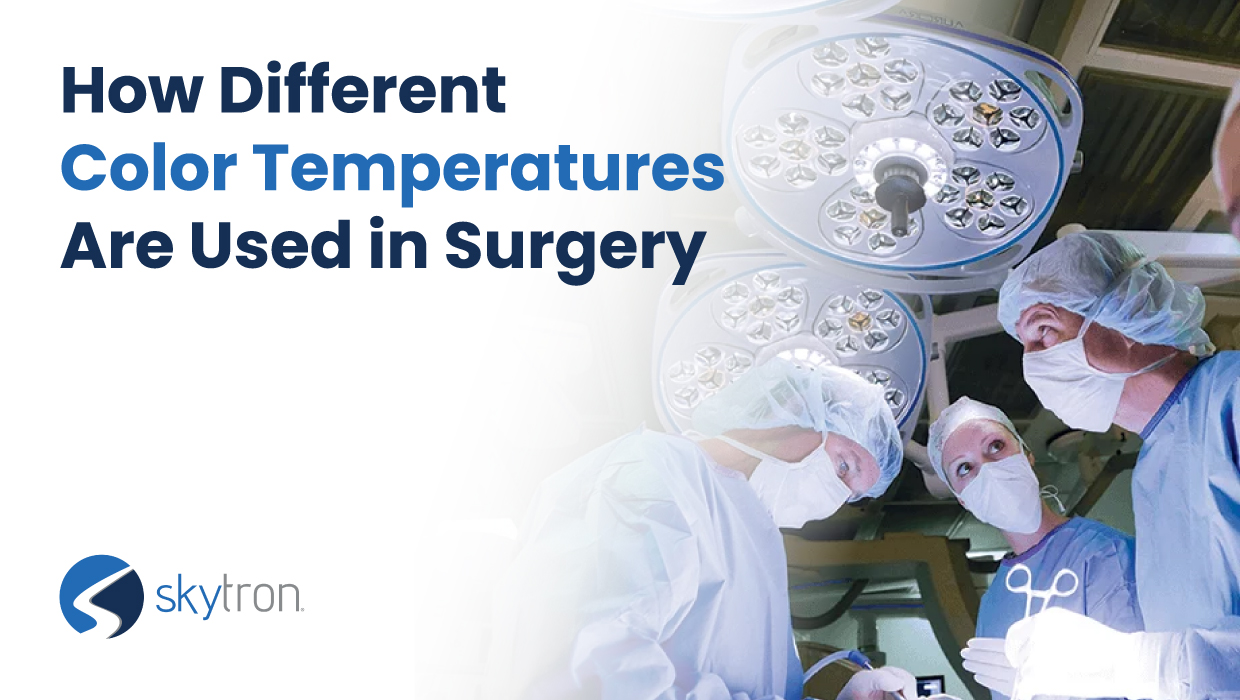
-
Written ByRebecca Kinney
-
PublishedSeptember 6, 2024
Room lighting is the general illumination that lights up the entire OR space. This type of lighting ensures that the surgical team can move safely and see their surroundings.
In the operating room (OR), precision, visibility, and attention to detail are big components of successful surgical outcomes. We all know how important having great surgical lights is, but how do the color temperatures of the light our docs select change things? The color temperatures aren’t just about visibility; they are critical to enhancing the surgeon’s ability to distinguish tissues, reduce eye strain, and improve overall efficiency.
This write-up will explain why different color temperatures are needed in surgery and what each color temperature represents, separating the roles of room lighting and surgical lighting.
The Role of Light in Surgery
Before discussing specific color temperatures, it’s important to understand the fundamental role of light in surgery. In an OR, there are two primary types of lighting: room lighting and surgical lighting. Each serves a distinct purpose and contributes to the overall environment in the operating room.
Room Lighting
Room lighting is the general illumination that lights up the entire OR space. This type of lighting ensures that the surgical team can move safely and see their surroundings. It is typically uniform and provides a baseline brightness level across the room.
Room lighting is usually designed to minimize shadows and reduce glare, creating a comfortable working environment. However, it does not focus directly on the surgical site and is not intended to highlight specific anatomical details. The color temperature of room lighting is generally chosen to create a natural and soothing environment, often resembling daylight, to keep the surgical team alert and reduce fatigue.
Surgical Lighting
Surgical lighting, on the other hand, is highly specialized and focuses directly on the surgical site. These lights are much brighter and more concentrated than room lighting, designed to provide intense illumination that enhances the visibility of the patient’s anatomy.
Surgeons rely heavily on surgical lighting to make precise incisions, identify tissues, and perform complex procedures. High-quality surgical lighting minimizes shadows on the surgical field and can be adjusted for intensity and color temperature to suit the needs of specific procedures.
However, not all tissues are the same color, and not all lighting is created equal. Different wavelengths of light can penetrate tissues to varying degrees, highlighting specific structures and improving contrast. This is where the color temperature of surgical lighting comes into play.
Color Temperature Measurements
According to AJ Knulst in the Standards and Performance Indicators for Surgical Luminaires color temperature, expressed in Kelvins (K), is a scale that measures the color of light a lamp produces.
This scale is based on the color changes observed in a piece of steel (referred to as a black body) as it is heated to specific temperatures. As the steel’s temperature increases, it glows in various colors, starting with red, moving through amber, then white, and finally reaching a bluish-white hue. Light sources with a color temperature above 5000 K are categorized as “cool colors,” which have a bluish tint. In contrast, those with lower color temperatures, between 2700 K and 3000 K, are known as “warm colors,” having a yellowish appearance, and are typically used for red tissue.
In surgical lighting, color temperatures typically range from 3,000K to 6,700 K. This range provides color-neutral illumination that enhances visibility and aids in accurate diagnostics.
White Light: The Standard for General Visibility
White light is the most used color temperature in surgical settings. It combines all visible wavelengths, providing a balanced illumination that closely mimics natural daylight. This is important because it offers a true-to-life view of the surgical field, allowing surgeons to distinguish between different tissues, such as skin, fat, muscle, and blood vessels. It is easiest to see bone.
The whites range from cool white for heightened clarity in intricate procedures to warm white.
White light is versatile and suitable for most general surgeries. It provides the broad spectrum needed to differentiate tissue colors, making it easier for surgeons to identify anomalies and perform procedures precisely.
Blue Light: Enhancing Contrast and Visual Acuity
In Surgical Lighting:
Blue light, with its shorter wavelength, is particularly effective in enhancing the contrast between tissues, especially in highly vascular areas. It makes red-colored tissues, such as blood vessels, stand out more prominently. This is especially useful during cardiovascular procedures, where clear visibility of blood flow and vessel structure is critical.
Moreover, blue light can help reduce eye fatigue during long surgeries. When exposed to blue light, surgeons are less likely to experience visual strain, which maintains clarity and sharpness without overwhelming the eyes.
Green Light: Reducing Glare and Enhancing Comfort
Green light is another important color temperature in the surgical lighting spectrum. It is often used with white light to reduce glare and improve the surgeon’s comfort. Green light is less harsh on the eyes and helps reduce the surgical field’s overall brightness without compromising visibility.
Green lighting is occasionally used in OR room lighting to create a calming atmosphere and to balance the intensity of surgical lighting. While not as critical as surgical lighting, green room lighting helps minimize overall brightness and visual strain, particularly during longer procedures.
Red Light: Minimizing Light Reflection in Retinal Surgery
In Surgical Lighting:
Red light, though less commonly used, has a specific application in eye surgeries, particularly retinal surgery. Its longer wavelength means it is less likely to be reflected by the retina, which reduces the risk of phototoxic damage to the eye.
By using red light, surgeons can minimize the amount of light reflected back into their eyes, reducing glare and improving the precision of delicate maneuvers in retinal procedures. This makes red light an invaluable tool in ophthalmic surgeries where accuracy is crucial.
Yellow Light: Optimal for Soft Tissue Differentiation
In Surgical Lighting:
Yellow light balances the harshness of white light and the contrast provided by blue light. It is particularly useful in soft tissue surgeries where distinguishing between different layers is critical. Yellow light enhances the visibility of soft tissues, making it easier for surgeons to identify and differentiate between various structures.
In Room Lighting:
Yellow lighting is sometimes used in OR room lighting to create a warm and welcoming environment. While it does not directly impact the surgical site, it can help create an overall sense of comfort and relaxation in the OR, which is beneficial for the surgical team’s mental state during procedures.
The use of different light color temperatures in both room and surgical lighting is far more than a matter of preference or aesthetics; it’s a strategic choice that enhances surgical precision, reduces eye strain, and improves patient outcomes. Each color temperature plays a unique role, from providing general visibility in the room to improving contrast and reducing glare directly at the surgical site. By understanding the importance of these different wavelengths, surgical teams can optimize their lighting environments to ensure the highest standards of care.
Skytron’s innovative surgical lighting solutions are designed with these needs in mind, offering customizable options that allow surgical teams to tailor their lighting to the specific requirements of each procedure. By investing in the right lighting, your hospital or ambulatory surgery center can enhance both the surgeon’s experience and the quality of patient care.
Resources
1. “What Role Do Surgical Lights Play in a Surgical Setting?” | ValleyMed
2. “The Advantages of Narrow Spectrum Green Lighting in Operating Rooms” | Architectural Products
3. Barneoud J, Breysse JP, Testa R, Dalens H, Coulangeon LM, Michel S. Colour perception in medical environment and under high illuminance levels. CGIP’2000.
4. Knulst AJ. et al. Standards and Performance Indicators for Surgical Luminaires. Leukos. 2009, Vol6 No1 37-49






